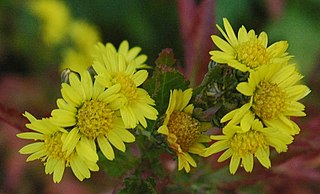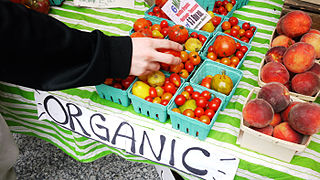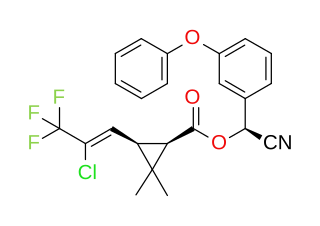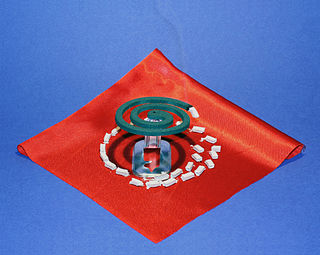
Organic farming, also known as ecological farming or biological farming, is an agricultural system that uses fertilizers of organic origin such as compost manure, green manure, and bone meal and places emphasis on techniques such as crop rotation and companion planting. It originated early in the 20th century in reaction to rapidly changing farming practices. Certified organic agriculture accounts for 70 million hectares globally, with over half of that total in Australia. Biological pest control, mixed cropping, and the fostering of insect predators are encouraged. Organic standards are designed to allow the use of naturally-occurring substances while prohibiting or strictly limiting synthetic substances. For instance, naturally-occurring pesticides such as pyrethrin are permitted, while synthetic fertilizers and pesticides are generally prohibited. Synthetic substances that are allowed include, for example, copper sulfate, elemental sulfur, and veterinary drugs. Genetically modified organisms, nanomaterials, human sewage sludge, plant growth regulators, hormones, and antibiotic use in livestock husbandry are prohibited. Organic farming advocates claim advantages in sustainability, openness, self-sufficiency, autonomy and independence, health, food security, and food safety.

Pittsburg is a city in, and the county seat of, Camp County, Texas, United States. Best known as the former home of the giant poultry producer Pilgrim's and the home of racing legend Carroll Shelby. In 1902, it was the site of an early flight attempt by the Ezekiel Air Ship Mfg Co. With a 2020 census-tabulated population of 4,335, it is the most populous city in Camp County.

Insecticides are pesticides used to kill insects. They include ovicides and larvicides used against insect eggs and larvae, respectively. Acaricides, which kill mites and ticks, are not strictly insecticides, but are usually classified together with insecticides. The major use of Insecticides is agriculture, but they are also used in home and garden, industrial buildings, vector control and control of insect parasites of animals and humans. Insecticides are claimed to be a major factor behind the increase in the 20th-century's agricultural productivity. Nearly all insecticides have the potential to significantly alter ecosystems; many are toxic to humans and/or animals; some become concentrated as they spread along the food chain.
The following outline is provided as an overview of and topical guide to sustainable agriculture:
Pyrethrum was a genus of several Old World plants now classified in either Chrysanthemum or Tanacetum which are cultivated as ornamentals for their showy flower heads. Pyrethrum continues to be used as a common name for plants formerly included in the genus Pyrethrum. Pyrethrum is also the name of a natural insecticide made from the dried flower heads of Chrysanthemum cinerariifolium and Chrysanthemum coccineum. The insecticidal compounds present in these species are pyrethrins.

Chrysanthemums, sometimes called mums or chrysanths, are flowering plants of the genus Chrysanthemum in the family Asteraceae. They are native to East Asia and northeastern Europe. Most species originate from East Asia and the center of diversity is in China. Countless horticultural varieties and cultivars exist.

The pyrethrins are a class of organic compounds normally derived from Chrysanthemum cinerariifolium that have potent insecticidal activity by targeting the nervous systems of insects. Pyrethrin naturally occurs in chrysanthemum flowers and is often considered an organic insecticide when it is not combined with piperonyl butoxide or other synthetic adjuvants. Their insecticidal and insect-repellent properties have been known and used for thousands of years.

The organic movement broadly refers to the organizations and individuals involved worldwide in the promotion of organic food and other organic products. It started during the first half of the 20th century, when modern large-scale agricultural practices began to appear.

Integrated pest management (IPM), also known as integrated pest control (IPC) is a broad-based approach that integrates both chemical and non-chemical practices for economic control of pests. IPM aims to suppress pest populations below the economic injury level (EIL). The UN's Food and Agriculture Organization defines IPM as "the careful consideration of all available pest control techniques and subsequent integration of appropriate measures that discourage the development of pest populations and keep pesticides and other interventions to levels that are economically justified and reduce or minimize risks to human health and the environment. IPM emphasizes the growth of a healthy crop with the least possible disruption to agro-ecosystems and encourages natural pest control mechanisms." Entomologists and ecologists have urged the adoption of IPM pest control since the 1970s. IPM is a safer pest control framework than reliance on the use of chemical pesticides, mitigating risks such as: insecticide-induced resurgence, pesticide resistance and (especially food) crop residues.

A pyrethroid is an organic compound similar to the natural pyrethrins, which are produced by the flowers of pyrethrums. Pyrethroids are used as commercial and household insecticides.
Persian powder is an insecticide powder with natural pyrethrin as the active agent. It is also known as Persian pellitory, insect powder and internationally as pyrethrum.

Organic horticulture is the science and art of growing fruits, vegetables, flowers, or ornamental plants by following the essential principles of organic agriculture in soil building and conservation, pest management, and heirloom variety preservation.

Jerome Irving Rodale, né Cohen was a publisher, editor, and author who founded Rodale, Inc. in Emmaus, Pennsylvania, and The Rodale Institute, formerly the Soil Health Foundation.
Guy Sternberg is the owner and operator of Starhill Forest Arboretum in Petersburg, Illinois. He is an arborist, author of books on oaks and is a founding member of the International Oak Society, tree consultant, and lecturer.
Neil Sperry is a Texas gardening and horticulture expert known for his books, magazine, radio program, and annual gardening show. Sperry was born and raised in College Station, Texas where he graduated A&M Consolidated High School as Salutatorian and Student Body President. He attended Texas A&M University and earned horticulture degrees from Ohio State University. He married his wife Lynn in 1967, and they now live in McKinney, Texas.
This is an alphabetical index of articles related to gardening.
Angus Stewart is an Australian horticulturist, gardening author and former television presenter on Gardening Australia.

Cyhalothrin is an organic compound that, in specific isomeric forms, is used as a pesticide. It is a pyrethroid, a class of synthetic insecticides that mimic the structure and properties of the naturally occurring insecticide pyrethrin which is present in the flowers of Chrysanthemum cinerariifolium. Pyrethroids such as cyhalothrin are often preferred as an active ingredient in agricultural insecticides because they are more cost-effective and longer acting than natural pyrethrins. λ-and γ-cyhalothrin are now used to control insects and spider mites in crops including cotton, cereals, potatoes and vegetables.

A mosquito coil is a mosquito-repelling incense, usually made into a spiral, and typically made using dried paste of pyrethrum powder. The coil is usually held at the center of the spiral, suspending it in the air, or wedged by two pieces of fireproof netting to allow continuous smoldering. Burning usually begins at the outer end of the spiral and progresses slowly toward the center of the spiral, producing a mosquito-repellent smoke. A typical mosquito coil measures around 15 centimetres (6 in) in diameter and lasts around seven to twelve hours. Mosquito coils are widely used in Asia, Africa, South America, Canada, Mexico and Australia.

Tefluthrin is the ISO common name for an organic compound that is used as a pesticide. It is a pyrethroid, a class of synthetic insecticides that mimic the structure and properties of the naturally occurring insecticide pyrethrin which is present in the flowers of Chrysanthemum cinerariifolium. Pyrethroids such as tefluthrin are often preferred as active ingredients in agricultural insecticides because they are more cost-effective and longer acting than natural pyrethrins. It is effective against soil pests because it can move as a vapour without irreversibly binding to soil particles: in this respect it differs from most other pyrethroids.












